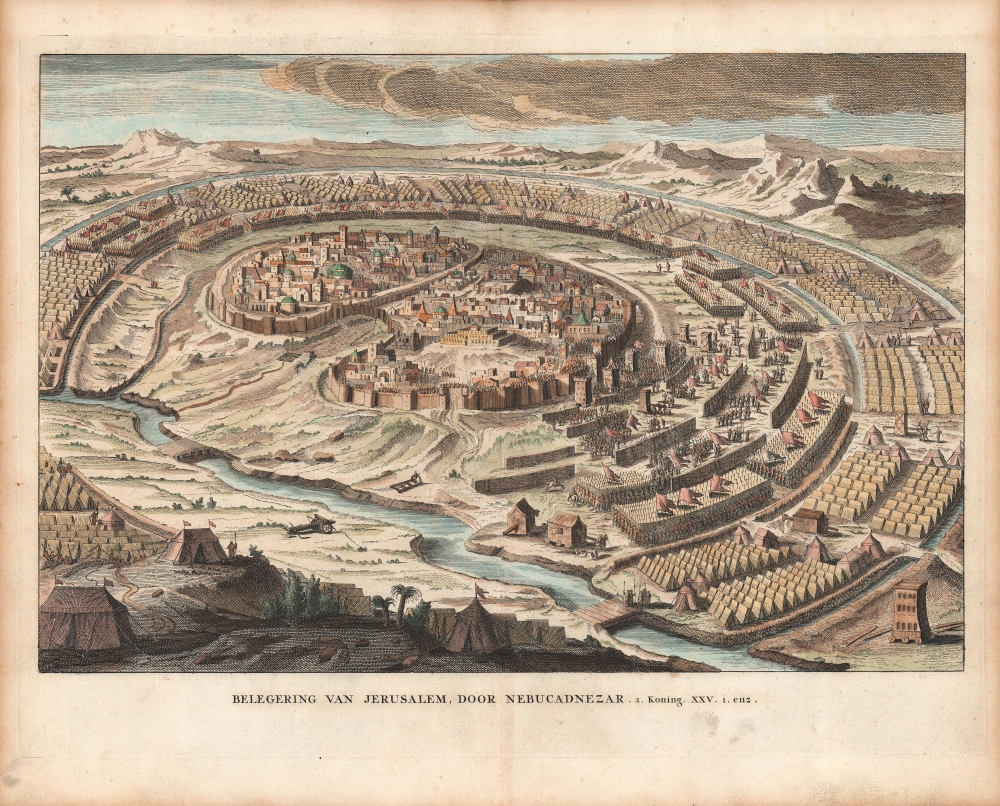1730 Calmet View of Nebuchadnezzar's Siege of Jerusalem
Jerusalem-calmet-1730
Title
1730 (undated) 12 x 17.5 in (30.48 x 44.45 cm)
Description
A Closer Look
This view depicts Jerusalem surrounded by Nebuchadnezzar's army, as described in the last part of the Book of Kings. The First Temple, or Solomon's Temple, which was destroyed during the city's capture, sits near center. The siege was especially long and difficult, lasting many months (the exact number is disputed, but likely was between 18 and 30). Both Biblical descriptions and archaeological evidence indicate that Jerusalem was completely destroyed at the end of the siege and its inhabitants led off into captivity.Publication History and Census
This view appeared in a Dutch translation of Antoine Augustine Calmet's Dictionnaire historique, critique, chronologique, géographique et littéral de la Bible. A folio supplement was later added to Calmet's work, and the entire three-volume work was subsequently translated and elaborated by Jakob van Ostade and Arnoldus Henricus Wetserhovius. The supplemental folio was published as Byvoegzel tot het algemeen groot historisch, oordeelkundig, chronologisch, geografisch, en letterlyk naam- en woord-boek, van den ganschen H. Bybel. This view is only independently cataloged among the holdings of Stanford University, while the entire Dutch folio supplement is more widely distributed in institutional collections.Cartographer
Antoine Augustin Calmet (February 26, 1672 - October 25, 1757) was a French Benedictine monk and Biblical scholar active in the late 17th and early 18th century. Calmut was born at Ménil-la-Horgne in Lorraine. He joined the Abbey of St-Mansuy at Toul in 1688. Approximately ten years later he was assigned to teach philosophy and theology in Moyenmoutier Abby. There he gathered the various materials and commentary with which he would eventually compose his important theological studies. Calmet's work initiated a new era of Biblical exegesis in which the dominant allegorical approach to theological analysis was replaced with a critical search for meaning and significance. Calmet was a religious as well as a learned man, and one of the most distinguished members of the Congregation of St. Vanne. In recognition of these qualities he was elected prior of Lay-Saint-Christophe in 1715, abbot of St-Léopold at Nancy in 1718, and of Senones Abbey in 1729; he was also twice entrusted with the office of president or superior general of the congregation. Pope Benedict XIII wished to confer Episcopal Dignity upon him, but in his humility could not be brought to accept the honor. Among Calmet's more interesting works is a 1746 treatise that ambiguously, though not explicitly, considers the existence of Vampires. Calmet died at Senones Abbey, near Saint-Dié, on 25 October 1757. More by this mapmaker...

